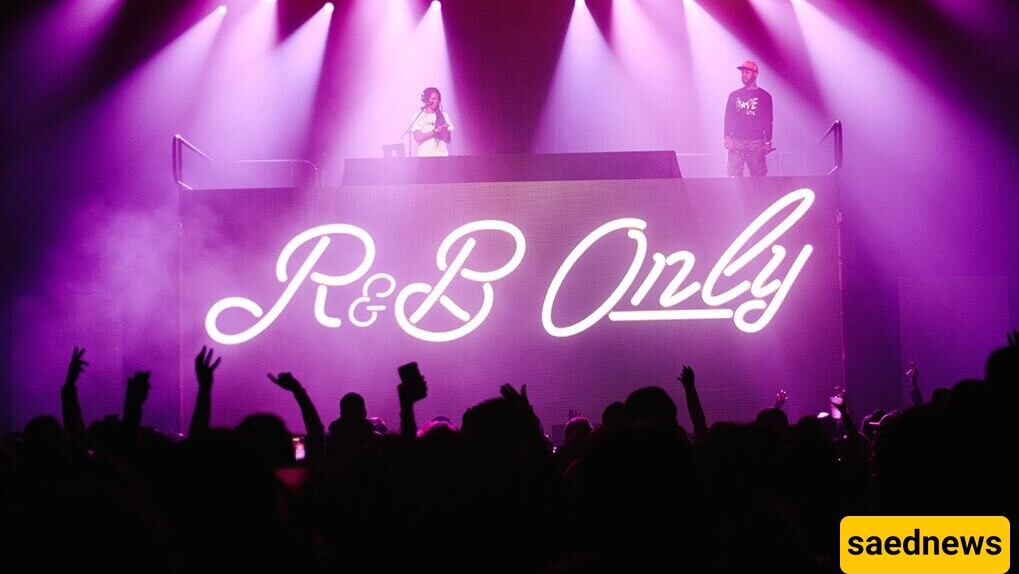R&B (Rhythm and Blues) is a popular music genre that has absorbed influences from jazz, gospel, and blues, encompassing the rich and diverse African-American music as well as other American styles. In this section of Saad News, we introduce the R&B music style.

R&B (Rhythm and Blues) is a Western music genre derived from Rhythm and Blues. In this article, we aim to introduce you to this musical style. Please stay with us until the end of this article.
This style, which emerged in the 1990s, combines soul, funk, and hip-hop music. In fact, it is one of the most popular and beloved genres in music, having incorporated influences from jazz, blues, and gospel. It is also noteworthy that R&B, in later decades, separated from rock music. Contemporary R&B is often driven by keyboards, synthesizers, strong bass lines, and circular drum beats. In this regard, it shares more similarities with hip-hop than with rock music. Contemporary R&B songs frequently top the charts, making it one of the most commercially successful genres in modern music. Notable and successful figures in this field include Michael Jackson, Stevie Wonder, Whitney Houston, Mariah Carey, and Beyoncé.
In the 1940s, R&B music spread in urban centers like New York, Chicago, Detroit, Philadelphia, and Los Angeles, due to the great migration of African Americans.
Many musicians immersed in blues and African-American church music brought new songs from the South and eventually signed recording contracts in northern cities. Their music focused on electric guitar, double bass, piano, and drum sets.
Early stars of this genre were often classified as both R&B and Rock ‘n’ Roll musicians, including James Brown, Fats Domino, and Little Richard. Chicago’s Chess Records promoted R&B singers who had transitioned to blues, like Bo Diddley and Chuck Berry, both also rock musicians. In the 1950s, R&B shared almost all of its musical characteristics with rock ‘n’ roll, but both genres began to acquire racial connotations due to widespread separation. By the 1950s and 1960s, almost all white musicians performing blues-based pop music were categorized as rock 'n' roll artists, while most black musicians playing similar music were classified as R&B artists.
Singers like Etta James and Sam Cooke gave pop music a smoother appearance, while white rock musicians leaned towards heavier sounds and psychedelic experiences. R&B began to share more commonalities with the emerging soul music style. Motown Records in Detroit created a commercial, sleek sound focused on dazzling singers and prominent rhythm sections. In Memphis, Stax Records blended Southern blues with a soulful sound from artists like Otis Redding and Carla Thomas.
R&B musicians in the 1970s began using syncopated rhythms and African-influenced lyrical content. Artists like Isaac Hayes and Al Green fused African rhythms with musical instruments, leading to the birth of funk and disco.
In recent decades, R&B music has distanced itself from the guitar and moved towards a smoother, laid-back sound suited for dance clubs and urban radio. Artists like Toni Braxton, Mariah Carey, Michael Jackson, Janet Jackson, Boyz II Men, TLC, Usher, and Lauryn Hill have won Grammy Awards and topped charts with their soulful, melismatic (ornate vocal) performances and catchy melodies. Beyoncé, Drake, and Mary J. Blige have pushed the rhythmic boundaries of R&B through collaborations with rappers and electronic producers.

Keyboard-based: While early R&B was mainly guitar-driven, contemporary R&B often uses keyboards, synthesizers, and drum machines (electronic instruments that produce beats and patterns).
Hip-hop Integration: In recent years, the line between hip-hop and R&B has blurred. Bryson Tiller’s Trapsoul and Drake's Thank Me Later feature equal parts singing and rapping. This trend traces back to the 1980s when producers like Teddy Riley and Bernard Belle introduced the new jack swing songwriting style.
Soft, Melismatic Vocals: R&B singers like Luther Vandross, Whitney Houston, and Mariah Carey made vocal skill an inseparable part of the genre, supported by artists like Jazmine Sullivan, Alicia Keys, and Erykah Badu.
R&B, with its unique rhythm and lyrics, is distinctly different from other genres. The genre has heavily been influenced by soul and rap. Specific features that set R&B apart from other genres include groove, timber (describing sound quality), and a variety of voice tones, from smooth to rough. R&B singers often have rich, deep voices, and many songs in this genre use call-and-response vocal techniques. Lyrics, rhythms, and musical notes are often repeated, and the close combination of instruments can make it difficult to distinguish the exact instruments used.

Chuck Willis
Joe Turner
Muddy Waters
These musicians are some of the prominent R&B artists. While the popular music of white Americans was complex and polite, R&B music was raw, straightforward, and full of spirit. These elements played a crucial role in the acceptance of this music among white audiences in the 1950s, who were seeking a musical alternative to white mainstream pop music.
Rock and roll is also considered a branch of R&B music, although it has been greatly influenced by country music.
R&B (Rhythm and Blues) is an African-American music genre that began in the 1940s. It has influences from jazz, gospel, and blues, and includes both African-American and other American music styles. The United States is known as the birthplace of the R&B genre.

